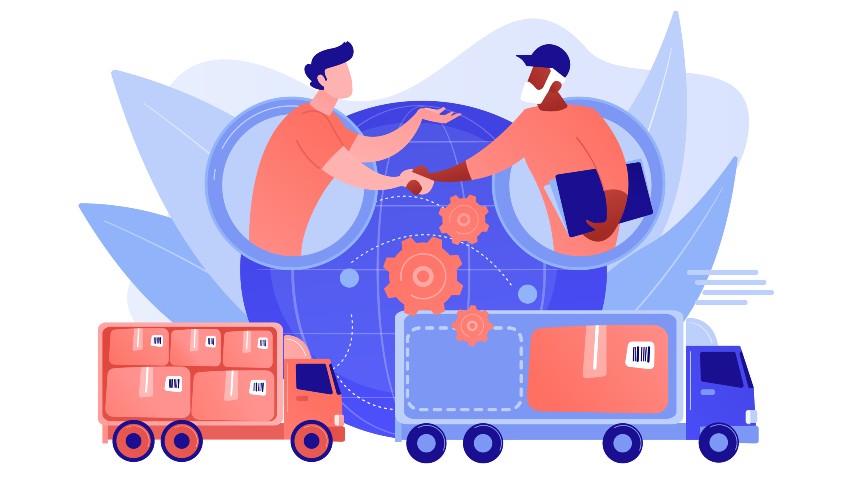Understanding the What, Why, and How of Supply Chain Risk Management

“A chain is as good as its weakest link” – the supply chain is as good as its weakest link. Businesses need to identify the weakest link in the supply chain and strengthen it. The process of identifying the weakest link in the supply chain and mitigating the risks associated with it is what supply chain risk management is all about. A solid supply chain risk management plan is needed to overcome the supply chain management risks and challenges.
Components of Supply Chain
The supply chain is the complete system of producing and delivering a product or service, right from sourcing to final delivery of the product or service. The supply chain entails all aspects of the production process, including activities at each stage, communicated information, and resources that are transformed into materials. Mapping out the supply chain is one of the critical steps in performing an external analysis in a strategic planning process. Understanding the supply chain carefully helps a company define its market and decide where it wants to be in the future.
The components of the supply chain are different in different industries. A generic supply chain for a manufacturing company begins with the sourcing and extracting raw materials required for the product. The sourced raw materials are transported from the supplier to the manufacturer. The raw materials are converted into the finished product on the manufacturing floor. Finished products are sent to the distributor at wholesale rates, after which they are given to the retailers. The retailer sells the product to the consumer. This is the last step in the supplier chain. The main external factor that drives the supply chain is consumer demand.
The supply chain for an e-commerce company begins when the customer places an order for the product on the company’s website. A checkout cart, ordering system, payment system, and delivery system are the main components of the supply chain of an e-commerce company. Most companies have their own payment systems, in some cases, third-party payment gateways are used. Once the order is placed, the warehouse receives the order and checks if the product is ready for delivery. The warehouse company sends the product to the shipping company. The shipping company finally delivers the product at the company’s doorstep.
Mapping the components of the supply chain helps identify supply chain risks effectively.
Types of Supply Chain Risks
What is supply chain risk? The supply chain risk definition is any disruption in the supply chain that could harm the overall organization, the business processes, business revenue, or the output of goods and services. Any disruption to the supply chain is considered a risk. For supply chain leaders, supply chain risk matrix assessment and adaptation are important aspects of their job responsibilities.
To assess, monitor, and mitigate supply chain risks, the management first needs to understand the types of risks and their causes. What is some supply chain risks? Supply chain risk is associated with economic, geopolitical, environmental, and cybersecurity factors. Here are some of the top supply chain risks:
Labor and Union Issues:
in manufacturing concerns labor unions are common. Changes in employee contracts wages or hours of employee work need to go through the union, hence, take a long time to get implemented. It is important to have the right insurance policy in place to ensure that the supply chain is not disrupted.
Financial risks:
these risks can occur from an unexpected or unfavorable change in the exchange rates. The financial risks associated with suppliers are bankruptcy, logistic issues, unexpected overruns, etc. Other types of financial risks are budget overruns, constructive changes, additional funding requirements, and missed milestones.
Supply risks:
What is supply risk? Supply risks are those that occur when raw materials required by the business are not delivered on time or are damaged, thereby causing disruption to the supply chain flow.
Demand risks:
demand risks are caused due to miscalculations in product demand. These miscalculations are caused by a lack of insight into annual purchasing trends or unpredictable demand.
Business risks:
unexpected changes in any one of the business entities that are needed to keep the supply chain running smoothly are termed as business risks.
Environmental risk:
any supply chain disruption that is caused by natural events is categorized as an environmental risk. Extreme weather conditions, pandemics, and natural disasters are environmental factors that may disrupt the supply chain. Environmental risks may either be global or local, and the disruption to the chain may be severe or mild.
Geopolitical risks:
disruption to the supply chain caused by global political events is categorized as geopolitical risk. Possible geopolitical risks are political instability or unrest, protest movements, corruption, trade restrictions and tariffs, and terrorism or pirating. The risk is greater when multiple risks occur at once.
Economic Risks:
the next factor is the economic risk that occurs when demand spikes, port, and border delays, currency fluctuations, material shortages, and price volatility. For example, weaker demand may bring the prices down, or delay in shipment may cause a reduction in prices.
Cybersecurity risk:
the risk that arises from compromise on the protection of sensitive business information, trade secrets, or intellectual property broadcast across the industry. Some of the cybersecurity risks are ransomware hacks, data theft, and intellectual property theft.
Root Cause of Supply Chain Risk
Supply chain risk assessment is the first step to mitigating supply chain risk. Root cause analysis is a structured way of addressing issues. Irrespective of whether the risks are internal (arise within the company’s operational walls and are subject to mitigation by managers and planners), or external (factors that are outside the company’s control like a supplier or partner efficiency).
Inefficient adoption of technology trends:
manufacturing concerns that are heavily dependent on the supply chain, suppliers, and other players in the supply chain that do not adopt technological trends are at a high risk of losing the competitive edge. Right from demand planning and forecasting to payment processing – integrated, intuitive software can be used to improve the efficiency of the supply chain. Software solutions enable planners to gain visibility over the entire supply chain and enhance customer satisfaction. Businesses that do not adopt such solutions increase supply chain risk.
Natural or environmental occurrences:
natural and environmental disasters are one of the most challenging disruptions to the supply chain. Such risks are potentially damaging to the business and often have a ripple effect on business operations.
Inaccurate demand planning and forecasting:
inaccuracies in demand planning and forecasting cause bottlenecks in the supply chain. Using outdated manual methods to forecast demand often results in inaccuracies. Factors like facility capacity, yard management, container management, and transportation management need to be considered while forecasting future requirements.
The shift in Governmental Regulations:
dynamic nature of governmental regulations and policies is an external risk to the supply chain. A supply chain management strategy that does not factor in regulatory changes is a recipe for disaster. Taxations, trade restrictions, border controls, and labor laws are some of the factors that affect supply chain operations. Failure to adhere to and stay updated with government regulations is a supply chain risk.
Price fluctuations:
price fluctuations in fuel costs, route efficiency, and port complications are some of the factors that cause supply chain disruptions. These factors directly affect transportation costs in the supply chain.
What is Supply Chain Risk Management?
Supply chain risk management (SCRM) definition is the process of taking strategic steps that can help companies identify, analyze, assess, and mitigate the risk in the supply chain. Supply chain risk management processes can be broken into risk identification, assessment, and mitigation.
Supply chain risk identification:
the first step in supply chain risk management is identifying supply chain risks. The risk profile must be first established and then closely monitored and updated to add new risks.
Supply chain risk assessment:
once the risk profile is identified, the next step is to define the possible impact of the risk on the business. The risk assessment must consider the role of stakeholders that have a significant impact on sales, margins, or profit.
Supply chain risk mitigation:
accurate identification and assessment of risks enable effective risk mitigation planning. Risk mitigation strategies in supply chain management should include preventive and reactive action plans for risk management. These plans form the basis for addressing risk by following appropriate measures that supply and protect the brand.
Supplier risk management, environmental risk management, financial risk management, value chain risk management, geopolitical risk management, and demand risk management are some of the types of supply chain risk management processes that are followed by businesses. SCM risk management equips businesses to plan and manage activities around sourcing, procurement, conversion, and logistics management. One of the main reasons companies implement global supply chain risk management strategies is to gain a competitive edge.
Effective Supply Chain Risk Management Risk Strategies
The principles of supply chain risk management are focused not only on managing risks but also on saving costs in the process. The supply chain risk assessment checklist must include external supply risks and internal supply risks. Effective supply chain risk mitigation must cover all the supply chain risk factors so that the business is ahead of potential disruptions.
Some effective supply chain risk management strategies are listed below:
Prevention, preparedness, response, and recovery strategy (PPRR):
The PPRR model is a global supply chain risk management strategy. Taking precautionary measures for supply chain risk mitigation; being prepared with a contingency plan; executing the contingency plan to mitigate the impact of the disruption, and resuming normal operations as soon as possible, are components of the PPRR strategy.
Managing Environmental Risk:
environmental factors are unpredictable, hence, cannot be prevented. However, planning for environmental risk is possible. Supply chain risk assessment software helps plan proactively for environmental risks by providing deeper visibility into the structure of the supply chain.
Implement a logistics contingency plan:
a logistics contingency plan ensures business continuity in the event of supply chain disruption. The business must have a solid contingency plan or still better multiple contingency plans in order to manage supply chain risks.
Conducting internal risk awareness training:
building a risk awareness culture is a great way to mitigate supply chain risks. The risk training curriculum must throw light on the common risks and challenges and risk management best practices.
Consistently monitor potential risks:
constant supply chain risk monitoring is key to the protection of supply chain operations. By monitoring every level of the supply chain, potential risk indicators can be identified, and business operations can be streamlined.
Consolidate important data:
supply chain risk assessment data must be stored in a single, centralized, and well-organized library for easy access.
Businesses can adopt supply chain risk management technology in order to gain visibility into every level of the supply chain. Risk mitigation strategies for the supply chain can be made more effective by adopting supply chain risk management software.
Conclusion
Supply chain risk management is essential for managing the supply chain effectively. From supply chain risk identification to risk mitigation, supply chain management technology is available. Cflow is a workflow automation software that can automate key business workflows within minutes. Automating the procurement workflow provides greater visibility into various levels of the supply chain. To explore interesting workflow automation methods. needs. Sign up for a free trial of Cflow to experience the power of workflow automation.



